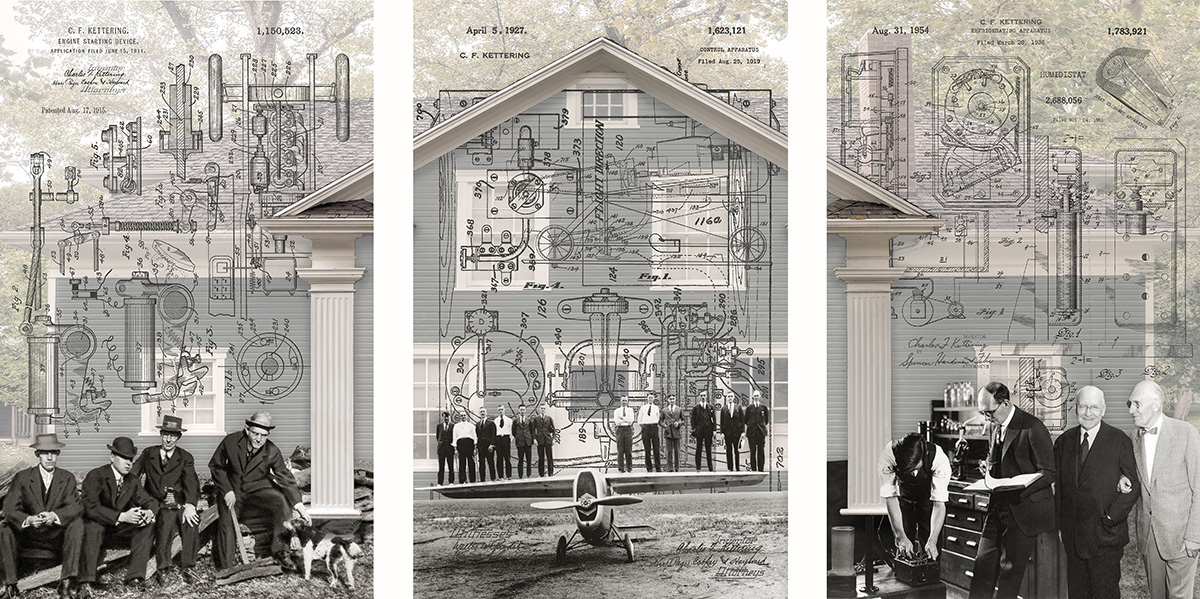ReImagining Works is a partnership between the Dayton Metro Library and The Dayton Art Institute to acquire original artwork for each of the Dayton Metro Library’s newly built or renovated branches. Giving creativity a central place in the “re-imagining” of the traditional role of the library, the Library is offering regional artists the opportunity to create a new work inspired by an artwork held in the permanent collection of The Dayton Art Institute. Bringing two of Dayton’s iconic institutions together, both places of discovery, inspiration and knowledge, ReImagining Works pays homage to artistic traditions of the past while creating art for the future.
After two years of effort, Dan Cleary's art piece at the Dayton-Montgomary County Kettering-Stroop library can finally be revealed. This art piece is called “Kettering, Deeds and Delco” and is based on the 50 year business relationship between Charles Kettering and Edward Deeds. It is located in the community room of the library. There was a large crowd and speeches by many dignitaries. The librarians asked if I could give them a description or key to this piece because they were already getting many questions about it.
The panel on the left has a photograph of a group of men called The Barn Gang. Edward Deeds worked at NCR Corporation and around 1906 hired Kettering straight out of college to work on electrifying the cash register. Kettering was so successful that Deeds invited him to do research for the automobile industry at his carriage house at Deeds home in Dayton. These people became known as the Barn Gang. The original Deeds barn is located inside the Carillon Historic museum. A replica of the Deeds barn is on the grounds of Carillon Historic park. I have used the Deeds barn as the background to my art piece on all three panels. At the Deeds barn Kettering invented the electric started for automobiles. Deeds and Kettering formed a company called Dayton Engineering Laboratories Company or DELCO for short to manufacture the starter. I have used Kettering’s original patent drawings for the self started in the left panel.
The center panel has a photograph of a group of men standing on the wing of an airplane. In 1917 Deeds, Kettering and Orville Wright formed a company called the Dayton-Wright Airplane company to provide airplanes to the military for WW1. Up to that point in time wings of airplanes were hollow and cloth covered. This photograph was to show how strong the solid wing of the RB-1 airplane was. The patent drawings in this panel are of the Bug Bomb that Kettering invented for the military in 1919. The bug bomb was a radio controlled aircraft and the world's first aerial missile. A forerunner to todays cruise missile. The war ended and the bug bomb was never used. A full size bug bomb is on display at the US Air-force Museum.
The right panel has two photographs. The left image is of Kettering and Lovell at the General Motors Research Corporation. And the right image is of Deeds and Kettering in 1951 after many years of friendship. DELCO was purchased by General Motors and Kettering became vice-president of General Motors Research Corporation in 1920 and held the position for 27 years. While at GM Research Corp. Kettering patented many inventions, including refrigeration, heat exchangers, thermostats, gasoline additives and many more. I have included parts of many of his patented during this period of his life in this panel.
The final part of this three panel triptych is the roof line of the Deeds Barn at Carillon Historic Park. This branch of the pubic library is located very close to where DELCO had it’s factory in east Kettering. To me this represents all the thousands of jobs Kettering and Deeds were able to provide with their companies and inventions. Those jobs provided people with employment and “a roof over their head’ for their family.




